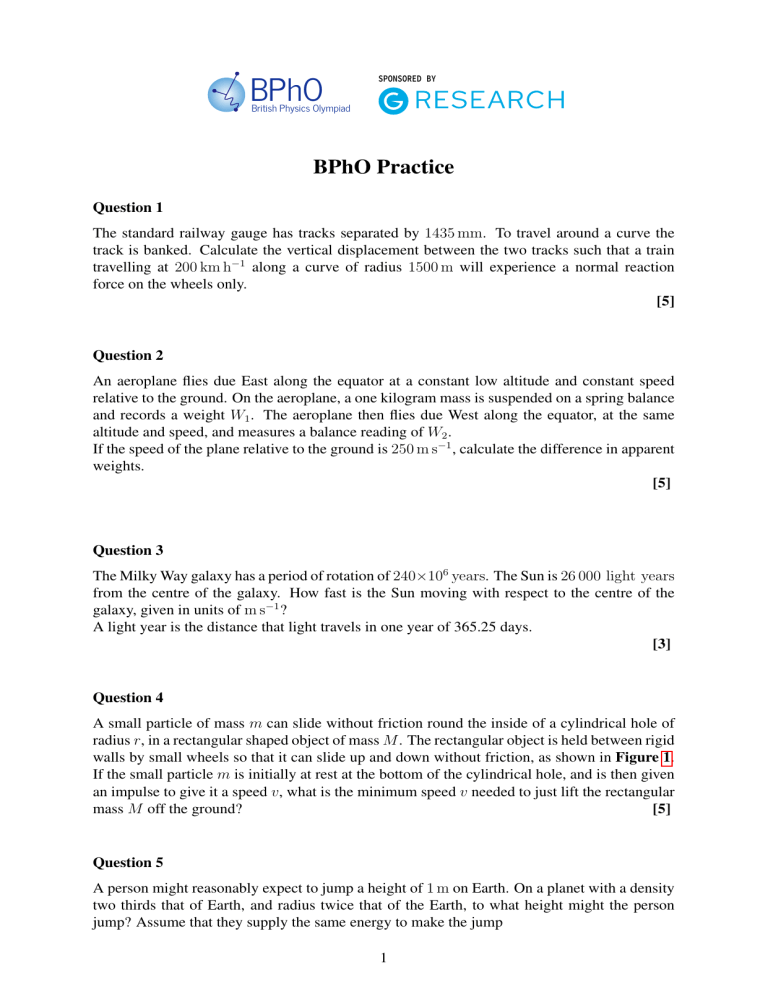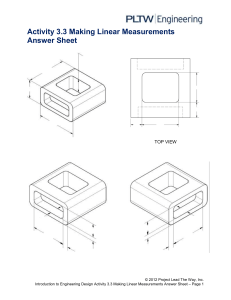
BPhO SPONSORED BY British Physics Olympiad BPhO Practice Question 1 The standard railway gauge has tracks separated by 1435 mm. To travel around a curve the track is banked. Calculate the vertical displacement between the two tracks such that a train travelling at 200 km h−1 along a curve of radius 1500 m will experience a normal reaction force on the wheels only. [5] Question 2 An aeroplane flies due East along the equator at a constant low altitude and constant speed relative to the ground. On the aeroplane, a one kilogram mass is suspended on a spring balance and records a weight W1 . The aeroplane then flies due West along the equator, at the same altitude and speed, and measures a balance reading of W2 . If the speed of the plane relative to the ground is 250 m s−1 , calculate the difference in apparent weights. [5] Question 3 The Milky Way galaxy has a period of rotation of 240×106 years. The Sun is 26 000 light years from the centre of the galaxy. How fast is the Sun moving with respect to the centre of the galaxy, given in units of m s−1 ? A light year is the distance that light travels in one year of 365.25 days. [3] Question 4 A small particle of mass m can slide without friction round the inside of a cylindrical hole of radius r, in a rectangular shaped object of mass M . The rectangular object is held between rigid walls by small wheels so that it can slide up and down without friction, as shown in Figure 1. If the small particle m is initially at rest at the bottom of the cylindrical hole, and is then given an impulse to give it a speed v, what is the minimum speed v needed to just lift the rectangular mass M off the ground? [5] Question 5 A person might reasonably expect to jump a height of 1 m on Earth. On a planet with a density two thirds that of Earth, and radius twice that of the Earth, to what height might the person jump? Assume that they supply the same energy to make the jump 1 M m Figure 1 [4] Question 6 A lead ball is attached to the end of a light metal rod of length l, the other end being attached to a horizontal axle of negligible friction. The rod is given an initial impulse and swings round in a vertical circle. When it is at the top of the circle, the tension in the rod is zero. What is the tension in the rod at the lowest point of its swing? [6] Question 7 Two spheres, of uniform density, one of mass m1 and radius r1 and the other of mass m2 and radius r2 , attract each other gravitationally. What is their relative speed at the instant of collision if they are released from rest when a great distance apart? [7] Question 8 A particle, mass m, slides down the smooth track, Figure 2, from a height H under gravity. It is to complete a circular trajectory of radius R when reaching its lowest point. Determine the smallest value of H. m R H Figure 2 [3] Question 9 2 A measurement is carried out to check the speed of a camera shutter of 1/15 s. The camera is focused symmetrically on a rotating turntable which revolves at 33.3 ± 0.1 revolutions per minute and has a spot at its centre and at its circumference. A photograph shows the arc produced by the spot on the circumference subtends an angle of 12.4 ± 0.1 ◦ at the centre of rotation. What is the correct exposure time? [3] Question 10 Figure 3 is a section through a smooth parabolic metal bowl, which can be rotated about its vertical axis of symmetry, the y-axis. Its equation, in Cartesian coordinates, is y = ax2 . The gradient at the point (x, y) is 2ax. There is one angular speed of rotation, ω, of the bowl about the y-axis for which a small metal sphere remains at rest relative to the rotating bowl, wherever it is placed on the inner surface. Determine ω in terms of a and g. [4] Figure 3 Question 11 Assuming the Earth is a homogeneous sphere, calculate the fractional difference between the acceleration due to free fall at the Earth’s equator and at the poles, indicating which is the greater. You may not use a value of g given in the constants table as that is an average value, neither correct at the poles nor at the equator. Mass of the Earth ME = 5.98 × 1024 kg Radius of the Earth RE = 6.38 × 106 m [8] Question 12 The largest moon of Jupiter, Ganymede, revolves around the planet in a circular orbit of radius 1.07 × 106 km and period 7.16 days. Determine the mass of Jupiter, MJ , in terms of the mass of the Earth, ME . The radius of the Earth RE = 6.38 × 106 m 3 [5] Question 13 In Figure 4 a fixed mirror, a light source and a light receiver are all 0.30 km from a rotating mirror, with angular frequency ω. The distance between the light source and the receiver is 0.60 m. What is the lowest value of ω required for detection of the reflected light? Figure 4 [4] Question 14 A velocity selector, Figure 5, consists of two slotted discs mounted on a common axis a distance d apart. The slots are displaced relative to each other by an angle θ. The axis is driven at an angular velocity ω. Particles in a horizontal beam, with all possible velocities, will get through the first slit, in the first disc, for a short time interval. To subsequently get through the second slit, particles must travel a distance d in the times it takes the second slot to line up with the beam. This will occur, for rotations of the second slit of θ, 2π + θ, 4π + ω, ... etc. If d = 1.00 m, ω = 24 000 rpm and 60◦ , what are the speeds of those particles that pass through the velocity selector? Figure 5 4 [5] Question 15 (i) A satellite is in orbit just above a spherical planet of radius R and uniform density ρ. If the periodic time for each orbit is T , find an expression for ρT 2 . Comment on the result. (ii) A man with a mass of 75 kg stands at the end of a diving board, depressing it by 0.30 m. What would be the period of his motion if he was to jump lightly in rhythm with the harmonic motion of the diving board? [6] Question 16 A mixed beam of deuterons (an isotope of hydrogen, 2H+ ) and protons, which have been accelerated through 1.00 × 104 V, enter a uniform magnetic field of 0.500 T in a direction at right angles to the field. Calculate the separation of the proton beam from the deuteron beam when each has described a semicircle in the field. [6] Question 17 The pulley system in Figure 6 consists of two pulleys of radii a and b rigidly fixed together, but free to rotate about a common horizontal axis. The weight W hangs from the axle of a freely suspended pulley P , which can rotate about its axle. If section A of a rough rope is pulled down with velocity V : (i) Explain which way W will move. (ii) With what speed will it move? Figure 6 5 [5] Question 18 Estimate the mean density of the Earth, in g cm−3 , assuming that the radius of the Earth RE = 6.38 × 103 km and the value of g = 9.81 m s−2 . State any assumptions made. [5] Question 19 A horizontal bar, 8.0 m in length, has a 2.0 m rope attached at each end, with a small metal sphere at each end of each rope hanging under gravity, Figure 7. When the bar rotates about a vertical axis through its centre, the ropes are inclined at 30◦ to the vertical. Determine the period, T , of rotation of the system. Figure 7 [5] Question 20 A smooth flat horizontal turntable 4.0 m in diameter is rotating at 0.050 revs per second. A student at the centre of the turntable, and rotating with it, releases a smooth flat puck on the turntable 0.50m from the edge. Describe the motion of the puck as seen by a stationary observer who is standing at the side of the turntable. a) How long does the puck remain on the turntable? b) At what relative velocity would the student, at the centre of the turntable, see the puck leave the turntable? [10] 6

